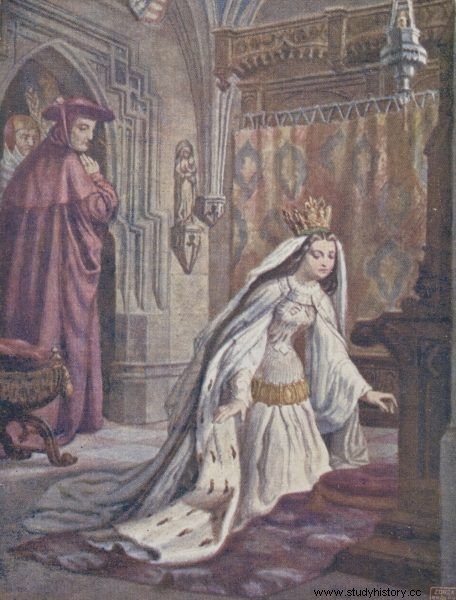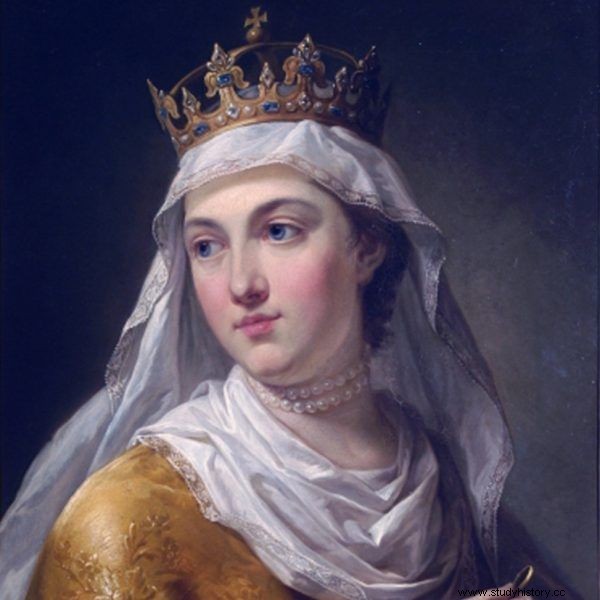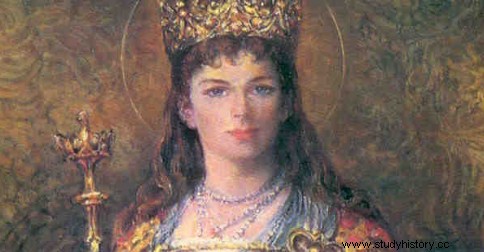She was considered a saint. She was beautiful, charismatic, self-aware. She was not afraid to stand on the front lines and confront the men. And although she lived only 26 years, she was enrolled as a powerful ruler. Here is Queen Jadwiga, a Polish monarch with a unique character, a woman who went down in the annals of not only Polish history.
Jadwiga belonged to the Anjou dynasty, a side line of the French Capetian dynasty. Its representatives ruled, for example, in Sicily, Hungary, Albania and Poland.
Royal Destiny
Jadwiga, most probably born on October 3, 1374, was the third daughter and the last child of the Hungarian king Louis of Anjou and Queen Elizabeth of Bosnia. The parents did not think that their youngest daughter would achieve the most out of all her siblings. As proof, it is impossible to look for a specific date of Jadwiga's birth in the chronicles. She may have been considered inconspicuous, but in a relatively short time she began to show her natural talents.
The daughter of Ludwik and Elżbieta was regarded as an extremely clever student, naturally bright, destined for matters of international importance. In 1386, on October 16 to be exact, Jadwiga became the first woman in Polish history to be crowned not a queen but a king.
Angel beautiful and devilishly intelligent
A monarch with Hungarian blood flowing in her veins could most likely be presented as a living role model, the embodiment of the most desirable virtues - not only in the Middle Ages. A harmonious blend of inner strength and outer charm. More or less this is how it was characterized by chroniclers. In his notes, Jan Długosz assured that there was no more beautiful woman in the world at that time. However, it is difficult to trust the words of a respected historian, as he was born after Jadwiga's death. Her husband, the Grand Duke of Lithuania Władysław II Jagiełło, was charmed by her beauty, and from the very beginning he was to be captivated by her smile.

Queen Jadwiga. A drawing by Jan Matejko based on the monarch's seal.
Anyway, careful examination of the skeleton shows that Jadwiga could actually arouse interest. Based on bone measurements, it was estimated that the queen's height varied between 175 and 182 centimeters. She was therefore unusually tall, especially for the time in which she lived. By examining the skull, collarbones and sternum, it was also possible to establish that Jadwiga had an extremely proportional, shapely build, most likely blond hair, which certainly could be considered a truly attractive woman.
Jadwiga was considered not only an attractive person, but also a very intelligent person. She eagerly looked into European book collections, appreciated art, was extremely charismatic and well-educated. You should know that she gathered representatives of the intellectual elite at her court, to mention only the Krakow bishop Piotr Wyższa, Mateusz from Krakow, a scholastic and theology from Prague. She read the writings of the doctors of the Roman Church, the Lives of Saint Bridget, commissioned the trilingual Florian Psalter. She took care of the spiritual development of the homeland.
Spiritual intellectual
She spoke several languages - Hungarian of course, also Latin, and at the same time German and, most likely, Czech. As a result of her efforts, the Krakow Academy was also renewed - because it was in Jadwiga's will, which Władysław Jagiełło took up after her death, that there was a provision that the personal property of the female king would be allocated to the Krakow university. The temple of knowledge had developed earlier, thanks to the special diplomatic efforts of Jadwiga Andegaweńska that arranged for it at the court of Pope Boniface IX. But that's not all.

"Queen Jadwiga before going to the wedding." Illustration from the first half of the 20th century
For Jadwiga Andegaweńska also gained fame and adoration as the founder of many new churches, as well as a kind of custodian - the guardian of already existing churches, especially monasteries. She also took special care of hospitals. In 1397 she founded a dormitory, which is simply a boarding house for both Polish and Lithuanian students at the Charles University in Prague. Thanks to her, the Hospital of the Holy Spirit was built in Biecz, the oldest surviving hospital in Poland. She tried to provide for similar institutions, which were also located in Sandomierz, Sącz and Stradom. Both city and church hospitals.
Calculated politician…
After the coronation, Jadwiga had to show cleverness and intelligence, thanks to which she could effectively rule on Polish soil. The full title of the ruler was: Hedvigis Dei gracia regina Polonie, necnon terrarum Cracovie, Sandomirie, Siradie, Lancicie, Cuiavie, Pomoranieque domina et heres which meant - no less, no more - Jadwiga, by God's grace, the queen of Poland, as well as the mistress and heiress of the lands of Krakow, Sandomierz, Sieradz, Łęczyca, Kujawy and Pomerania. The title was not insignificant. Jadwiga was considered an extremely competent person, which meant that all representatives of foreign governments came to her office. Władysław Jagiełło remained in the shadows, being influenced by the actions of his charismatic wife.
The Grand Duke of Lithuania, the founder of the Jagiellonian dynasty, successfully Christianized Lithuania, in which Jadwiga played a key role. There is a particularly symbolic inscription on her grave, which reads:"She brought the light of the Christian faith to the Gentiles" .

Queen Jadwiga. Portrait by Marcello Bacciarelli.
The art of diplomacy, in which a representative of the Anjou dynasty specialized, is also important. Because it was she who brought about an agreement between Władysław Jagiełło and his eternal rival, Prince Witold. Jadwiga turned out to be a seasoned politician, as evidenced by intelligently pursued politics with the Teutonic Order. In her relations with the Teutonic Knights, she strove to maintain peace, although she did not make any concessions to them. In retrospect, it is said that it was she who prepared the ground for the victory of the Polish army at Grunwald. It was she who cemented the alliances, thanks to which Władysław Jagiełło finally won.
… warlord
In the spring of 1387, Queen Jadwiga headed an armed expedition to Red Ruthenia, a historical land in north-western Ukraine and in south-eastern Poland. In the absence of Jagiełło, she led the march of troops - most towns and castles opened their gates for the Polish queen without a fight. However, near Stubno, in today's Podkarpacie region, the way for Polish troops was blocked by the Hungarian army. Two sisters stood in front of each other, because the army of Maria, Queen of Hungary, was already waiting on the other side. The extraordinary battle ended in the victory of Jadwiga. As a result of the decisions on the battlefield, the Hungarian starosts were removed, while the Red Ruthenia and Lviv joined Poland. Lviv soon became one of the leading Polish metropolises.

Queen Jadwiga
She was considered a saint. She was beautiful, charismatic, self-aware. She was not afraid to stand on the front lines and confront the men. And although she lived only 26 years, she was enrolled as a powerful ruler. Here is Queen Jadwiga, a Polish monarch with a unique character, a woman who went down in the annals of not only Polish history. There are other secrets in her biography. More to come soon.
